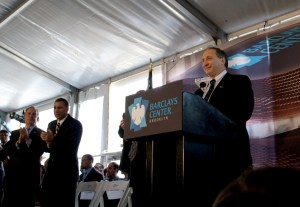Atlantic Yards and the Great Recession Groundbreaking
By Eliot Brown March 12, 2010 12:46 am
reprints There was an odd feel to Thursday afternoon’s Atlantic Yards groundbreaking—one that felt almost as though it wasn’t 2010, but rather, say, 2007, when the economy was vibrant and projects were popping up around the city.
There was an odd feel to Thursday afternoon’s Atlantic Yards groundbreaking—one that felt almost as though it wasn’t 2010, but rather, say, 2007, when the economy was vibrant and projects were popping up around the city.
A giant white party tent at the site of the Nets basketball arena-to-be in Prospect Heights quickly became filled with business leaders, lawyers, Nets investors and a celebrity or two, as a brigade of caterers passed around gourmet munchies—mini-burgers; cheesecake—squeezing in between an army of suits holding napkins that carried the new Barclays Center insignia. One after another, officials and executives key to the project—Mayor Bloomberg, Governor Paterson, Brooklyn Borough President Marty Markowitz—took to the lectern to address the tent, proclaiming just how pleased they were that the project was happening.
This is a very un-recession-like concept.
Big projects, particularly those that are built on what the developer says are slim margins, are not supposed to happen in economic downturns. Yet here we were, with ground-breaking on just one component of the $4.9 billion project—the component that was considered to be the least profitable of the project.
That Atlantic Yards developer Bruce Ratner and his Forest City Ratner got to Thursday’s tent is a testament to the developer’s perseverance and tenacity, pulling whatever levers he could to advance the highly controversial behemoth of a project. But in pushing the project through, it morphed, offering a cautionary tale of development with public approvals, illustrating how many of the selling points (a green roof, a world-class architect, 6,400 apartments in just a few years) can vanish when finances get tight.
KEY IN THE TALE of survival was the public sector, and its willingness to adjust earlier agreements.
Mr. Ratner, a onetime city official, almost exclusively concentrates on large projects that need one or another onerous government approval. He plays this game well, keeping an army of lobbyists on retainer, along with a highly experienced in-house team. Other developers and some government officials acknowledge Forest City is among the best, if not the best in the industry at applying pressure. The firm has strong links with labor, alliances that pay off in the form of bodies eager to rally on their behalf and union officials willing to pressure elected officials. Offering pledges of very significant below-market rate housing, Forest City hatched a deal with ACORN, the politically powerful housing group, which in turn became a vocal advocate for the project and also offered cover for those politicians who might have otherwise been opposed.
Forest City’s political force paid off in the form of renegotiations that saved tens of millions of dollars, if not more, by adjusting old agreements with the city and state. The company insisted that the project was on the brink and it needed new subsidies, petitioning the city on multiple fronts. They hit resistance and were not granted extra cash, but were permitted to reopen the terms and speed of payments in old deals.



